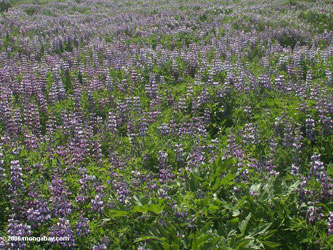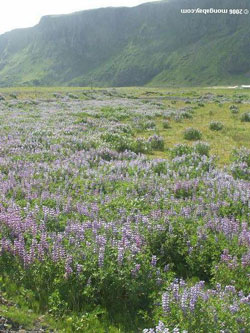Invasive purple flower impacts Iceland’s biodiversity
Invasive purple flower impacts Iceland’s biodiversity
Nootka Lupine: Purple Menace or Miracle?
Tina Butler
July 24, 2006
Erosion is the gravest environmental problem Iceland faces today. Foliage loss, and ultimately soil erosion, occurs across the island, due largely to the extreme conditions of the environment, in particular the high winds. Some cite the free-ranging sheep as an added threat, with their constant grazing on already scant plant growth. Measures have been taken to encourage new growth that would create anchors for the remaining soil, but these approaches have been controversial.
A common sight throughout much of Iceland is large fields of vibrant purple nootka, or Alaskan lupine. The flower looks at home in this landscape, but was actually introduced in 1945 to lowland areas in the southwest as a means to add nitrogen to the soil and also to function as an anchor for organic matter. Lupine has since flourished here, spreading to other regions like a wildfire, in almost effortless competition with the other species already in residence. Critics of this initiative view the flower as an invasive species that is threatening low-growing mosses and other native plants.
Close to 10,000 plant species have been introduced to Iceland, largely for private gardens. Fortunately, for the sake of native species, few have spread naturally. Lupine has been a significant exception, in part because of its high productivity. The accumulating litter from the plants enriches the earth and in turn increases organic matter. Lupine planting has proven to be the most successful method for re-vegetating barren lowland areas
 Alaskan lupine (Lupinus nootkatensis) is an invasive species affecting Iceland’s biodiversity. Photo by Tina Butler. One possible solution to the lupine problem is crossbreeding the plant to create a sweeter hybrid that free-ranging livestock could feed on. The plant has proven hardy and high yielding, but it contains bitter alkaloids that keep sheep and goats at bay. Making the lupine suitable for grazing and feed production could at once help control its spread, while protecting native plants. |
While this all sounds highly beneficial to the cause of halting erosion and increasing the volume and quality of soil, the lupine patches tend not to share the arable tracts they create. What is more, the comparatively tall lupine creates a canopy over the previously dominant lichens, mosses, and low shrubs, causing these species to decline in the newly formed shade. Ultimately, species diversity among plants declines as the lupine spreads.
After a long period of over grazing, native plant communities were already vulnerable when the lupine was introduced. A decline in sheep grazing in recent years has left areas to recover, but the lupine often takes over before native species can re-establish. The empty spaces have only encouraged the spread of lupine, a plant that has proven extremely difficult to contain.
 Photo by Tina Butler. |
The voracious lupine has even taken over significant stretches of the great sands in the eastern region of the island, an area where many thought nothing could grow. While this has been a great benefit to drivers, who have witnessed a precipitous drop in the road-closing sandstorms that plague the area, it is clear that an interruption of a natural process has occurred.
Botanists have noted that in some regions, lupine stands start to degenerate after 15-20 years, being replaced by other species that thrive in the rich soil left behind. This can be viewed as a benefit, but not an outcome that is guaranteed for every lupine field in Iceland.
Supporters of the lupine see a special value in its soil-enriching properties particularly for reforestation efforts on a landscape nearly bereft of trees. Most of Iceland’s trees were felled during settlement, close to 1100 years ago. The cause to reforest Iceland may be a noble one for some, but others believe it is too late to try and restore the country’s original ecosystem, believing it is better to let the sand, sea and wind lay their claim to the land.
Regardless of the plant’s ability to enhance or injure, lupine fields inflict a total transformation in plant composition and thus a significant transformation in the landscape. Iceland has a problem with erosion, but perhaps nature should be allowed to take its course.